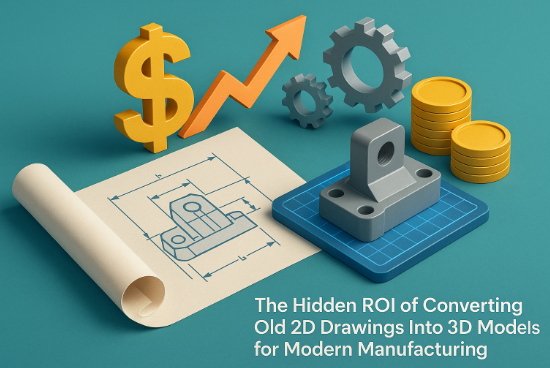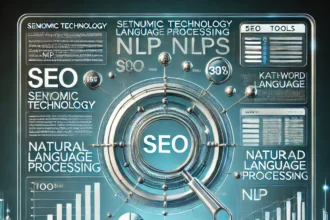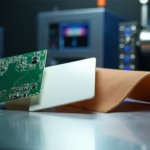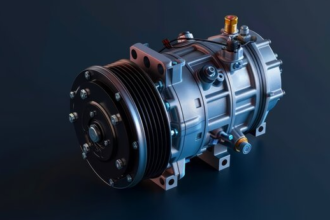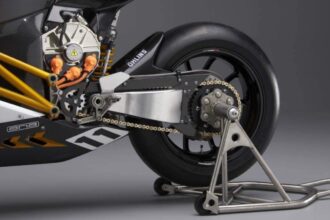Discover the hidden ROI of converting old 2D drawings into 3D models. Boost accuracy, cut costs, and modernise manufacturing with smart CAD conversion.
Imagine this: dusty cardboard tubes stuffed with yellowing paper blueprints in a warehouse. These very same drawings were once the sacred guides to your business’s most important designs. But now, in an age of rapid innovation and digital manufacturing, they sit idle hard to read, even harder to update. What if those lifeless 2D drawings could be transformed into powerful digital assets that drive real value?
That’s the hidden ROI of choosing to convert 2D drawing to 3D model. For business owners, engineers, architects, and design decision-makers in the UK (and globally), this isn’t just a technical upgrade, it’s a strategic investment. In this post, we’ll explore why that transformation matters today, what challenges it helps solve, and how it unlocks new opportunities in modern manufacturing.
Why Should You Convert 2D Drawing to 3D Model?
- Digital transformation & Industry 4.0: Modern manufacturers increasingly rely on digital twins virtual, 3D representations of physical assets to simulate, monitor, and optimise production.
- Explosive 3D printing adoption: According to Protolabs’s 2024 trend report, 70% of engineers and manufacturers said they printed more parts in 2023 than the year before. That means firms are not just prototyping, they’re manufacturing.
- UK market growth: The UK 3D-printing market is forecast to hit USD 3,049.4 million by 2033 (CAGR ~13.97%). And the 3D rendering market in the UK is also expected to grow fast (18.6% CAGR projected). Grand View Research
These trends make a compelling case: converting legacy 2D drawings into 3D CAD models aligns with where the industry is going, more digitised, more efficient, more data-driven.
What Are the Key Advantages of 2D to 3D CAD Conversion Services?
Here are some tangible gains when you invest in 2d to 3d cad conversion services:
- Improved Accuracy and Fewer Errors
- With a proper 3D model, you can visualise all dimensions, tolerances, and relationships clearly. That reduces misinterpretation compared to traditional 2D blueprints.
- Associative design means when you change something in the 3D model, all related views (drawings, assemblies, NC programs) update automatically.
- Shorter Design and Modification Cycles
- In 3D, it’s far easier to simulate modifications, validate form and fit, and iterate without starting from scratch on paper.
- This means time-to-market improves, and engineering teams can respond faster to customer feedback.
Better Use of Legacy Assets
- Many businesses have valuable but dormant assets only documented in paper form or old AutoCAD files. By converting them (e.g., 2d to 3d conversion in AutoCAD), you revive these assets for reuse.
- Companies such as Restoric in the UK specialise in converting paper blueprints or DWG files into detailed 3D CAD models (STEP, IGES, STL, etc.).
- Cost Savings in Manufacturing & Prototyping
- With a reliable 3D model, you reduce the need for multiple physical prototypes. Using simulation and validation tools, you can catch design flaws earlier, reducing scrap, rework, and wasted materials.
- Plus, if you’re using additive manufacturing (3D printing), a clean 3D CAD model feeds directly into the manufacturing pipeline accelerating production and cutting tooling costs.
- Cross-Functional Collaboration & Digital Continuity
- 3D CAD models support modern workflows: design, engineering, simulation, CAM, even marketing visuals and digital twins.
- Cloud-based CAD platforms and real-time collaborative tools are on the rise: over 42% of enterprises already enable real-time design collaboration. Market Growth Reports
- This cross-functional use means one investment (convert to 3D) can benefit multiple departments.
- Preserving Institutional Knowledge
- Older staff may leave, but legacy drawings often carry critical know-how. Digitising and converting them to 3D ensures that institutional knowledge isn’t lost.
- And because 3D models are editable and reusable, future engineers can build on past designs, not reinvent the wheel.
What Challenges Could Prevent or Slow Down 2D to 3D Conversion?
- Data Quality Issues: Old 2D drawings may be incomplete, unclear, or poorly annotated. Sometimes dimensions or views are missing. That’s why professional autocad conversion services must include a review and interpretation phase.
- Skill Gaps: Not all teams have in-house CAD experts who are proficient in reverse-engineering 2D to 3D. Hiring or outsourcing is often necessary.
- Cost Concerns: Some decision-makers hesitate at upfront conversion costs. But when you weigh them against long-term efficiency gains, error reduction, and reuse potential, the ROI often pays off quickly.
- Software & Compatibility: There are many CAD platforms (AutoCAD, SolidWorks, Creo, etc.), and converted data must integrate seamlessly. Choosing a service provider that delivers in neutral formats (STEP, IGES) is critical.
- Change Management: Moving from 2D-based workflows to 3D-first processes requires cultural buy-in. You may need to train teams, update standards, and re-evaluate existing processes.
What Are the Emerging Trends in CAD and Conversion That Boost ROI?
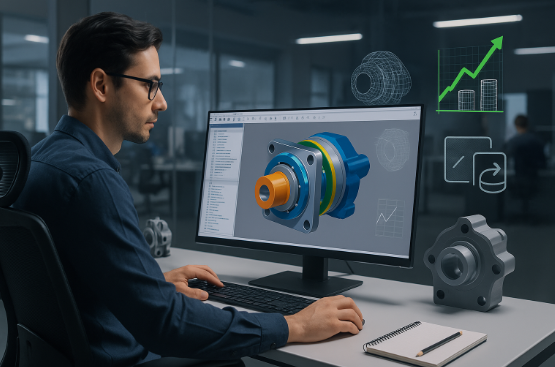
How Does the Future Look and Why Now Is a Great Time to Act
Here are some rising trends and innovations in the CAD world that make converting 2D drawings to 3D even more compelling:
- AI & Machine Learning in CAD: AI-driven modelling tools are reducing design time significantly. According to recent analysis, integrating AI into CAD platforms has delivered, on average, a 17% reduction in design time. Market Growth Reports
- Multimodal AI Interfaces: Cutting-edge research explores AI-driven interfaces that let users sketch, talk, or gesture to build 3D CAD models. These could make modelling more intuitive, further reducing barriers to creating digital versions of old 2D assets.
- Reverse Engineering & Quality Assurance: Using 3D scanning and coordinate measuring to validate converted models for example, matching a scanned part to its 3D CAD representation is increasingly common.
- Cloud Collaboration: Cloud-based and real-time collaborative 3D CAD platforms are lowering costs and making it easier for dispersed teams to work together.
- Sustainability Focus: Companies are increasingly conscious of waste and efficiency. By converting 2D legacy drawings into 3D digital models, you reduce the need for physical scrap, minimise rework, and drive more sustainable production.
How Can You Calculate the ROI of Converting 2D to 3D?
Here’s a simple way to frame the hidden ROI mathematically which can help convince stakeholders:
- Estimate conversion cost: Cost of 2d to 3d conversion in AutoCAD or other CAD tools + service provider costs (if outsourced).
- Estimate savings per year:
- Prototype cost reduction (fewer physical builds)
- Fewer manufacturing errors / rework
- Time saved on modifications / iterations
- Estimate value of reuse:
- How many legacy parts will be reused or modernised?
- Potential revenue or cost avoidance from remanufacturing or redesign
- Collaboration and efficiency gains: Value of reduced engineering hours, faster product development, better cross-department alignment.
- Intangible but real: Better team knowledge retention, futureproofing, reduced risk.
When you compute all that, the ROI often outweighs the initial investment and often faster than you expect.
Which Businesses or Sectors Benefit Most from This Conversion?
- Manufacturers with Legacy Parts: Especially in aerospace, automotive, machinery, and heritage industries parts may no longer be actively produced but are still needed.
- Restorers & Engineering Consultants: Firms that restore, refurbish, or replicate old equipment can modernise designs and open up new business lines.
- Startups Designing for Additive Manufacturing: Startups can take advantage of 3D printing, CAM workflows, and digital twins but they need clean 3D models as their foundation.
- Architects and Construction Firms: While 2D plans remain important, 3D models enhance coordination, clash detection, and digital twin creation.
- R&D Departments: Converting legacy designs allows R&D teams to simulate and re-engineer existing parts without starting from zero.
What to Look for in a Quality 2D to 3D CAD Conversion Service
When choosing a provider or partner, consider:
- Proven expertise in 2d to 3d cad conversion services, especially from messy or incomplete legacy formats.
- Experience with 2d to 3d conversion in AutoCAD, as many organisations still store designs in DWG or DXF.
- Delivery in a variety of standard 3D CAD formats (STEP, IGES, STL) for broad compatibility.
- Validation and quality control processes (e.g., reverse engineering, scanning) to ensure model accuracy.
- Good communication and domain knowledge: someone who understands your engineering intent, not just redrafts lines.
Is There Risk in Not Converting?
If you decide not to convert your 2D drawings into 3D:
- Your legacy designs may remain under-utilised, locked away in paper archives or outdated DWG files.
- You continue to incur risk from misinterpretation, errors, and costly rework.
- You miss out on efficiency gains of digital workflows simulation, CAM, digital twins, and 3D printing.
- You might fall behind competitors who are modernising and leveraging digital manufacturing strategies.
- Succession risk: institutional knowledge locked in old drawings could be lost as people move on.
Conclusion:
In the fast-moving world of modern manufacturing, especially here in the UK, where the 3D printing and CAD market is growing rapidly, converting your old 2D drawings into 3D models isn’t just a nice-to-have. It’s a strategic lever.
By investing in 2d to 3d cad conversion services, you:
- Revive legacy data for future product development
- Reduce errors and waste, driving down production costs
- Accelerate design cycles and speed up time-to-market
- Enable collaboration, digital twin creation, and additive manufacturing workflows
If your business is still relying on paper blueprints or dusty DWG archives, now is the moment to act. A trusted UK-based CAD design company (for example, a leading firm with deep experience in autocad conversion services and legacy drawing modernisation) can help you unlock that hidden ROI turning your historical designs into strategic digital assets.
Don’t let your past designs hold you back. Transform them, modernise them, and let them fuel your future innovation.


